- Home
- Ursula K. Le Guin
The Left Hand Of Darkness (SF Masterworks) Page 2
The Left Hand Of Darkness (SF Masterworks) Read online
Page 2
In reading a novel, any novel, we have to know perfectly well that the whole thing is nonsense, and then, while reading, believe every word of it. Finally, when we’re done with it, we may find—if it’s a good novel—that we’re a bit different from what we were before we read it, that we have been changed a little, as if by having met a new face, crossed a street we never crossed before. But it’s very hard to say just what we learned, how we were changed.
The artist deals with what cannot be said in words.
The artist whose medium is fiction does this in words. The novelist says in words what cannot be said in words.
Words can be used thus paradoxically because they have, along with a semiotic usage, a symbolic or metaphoric usage. (They also have a sound—a fact the linguistic positivists take no interest in. A sentence or paragraph is like a chord or harmonic sequence in music: its meaning may be more clearly understood by the attentive ear, even though it is read in silence, than by the attentive intellect).
All fiction is metaphor. Science fiction is metaphor. What sets it apart from older forms of fiction seems to be its use of new metaphors, drawn from certain great dominants of our contemporary life—science, all the sciences, and technology, and the relativistic and the historical outlook, among them. Space travel is one of these metaphors; so is an alternative society, an alternative biology; the future is another. The future, in fiction, is a metaphor.
A metaphor for what?
If I could have said it non-metaphorically, I would not have written all these words, this novel; and Genly Ai would never have sat down at my desk and used up my ink and typewriter ribbon in informing me, and you, rather solemnly, that the truth is a matter of the imagination.
Ursula K. Le Guin
INTRODUCTORY NOTE TO THE
40TH ANNIVERSARY EDITION
In 1976 I published an essay, ‘Is Gender Necessary?’ about some of the problems I had in writing this novel, the reasons why I wrote it as I did, and its reception by readers and critics. In 1988 I reconsidered what I’d said, reported some fairly radical changes in my thinking, and published the old text along with the suggested improvements, ending with a note – ‘I do very much hope that I don’t have to print re-reconsiderations in 1997, since I’m a bit tired of chastising myself.’
I got through 1997 without having to go back and chew on the old gender bones again; but here we are, twelve years after that and forty years after The Left Hand of Darkness first came out. Time to reconsider, perhaps, but not in a chastising mode. I feel more like celebrating.
* * *
If the phrase ‘gender construction’ had been invented in 1968, when I wrote the novel, I hadn’t heard it. Feminism was being reborn, but my own feminist education, which began with Virginia Woolf, was still plodding along behind the advance guard. I was always a feminist, but always a slow learner.
All the same, questions about the relative status of men and women were in the air, and they were interesting questions. What did ‘the division of labour’ really mean, and why did only some workers get wages? Why were the great human group institutions – religions, governments, armies, universities – set up and controlled by men? How much of the behaviour supposed to be a result of our gender is really a result of what our society expects of our gender? And so on. Interesting questions. I was interested. I thought about them. I thought in the form of thought my mind uses best: the story. What if I wrote a story, a thought experiment, about people who had no gender, or both genders? How would they behave? What would their society be like?
So there I was on Gethen, with Genly Ai, discovering these things.
That is more or less how I thought it happened and how I explained the process; now I know it didn’t happen quite like that.
After all, I had been on the ice age planet Gethen before, without noticing any peculiarities of Gethenian gender and sexuality. I’d written the story ‘Winter’s King’ in which the characters, all Gethenians, seem to be gender-divided just as we are. How did I get from there to the Gethen of The Left Hand of Darkness?
In trying to decide what to write for this introduction, I looked into a very old file-folder marked ‘WINTER’. There I found, along with charts of the journey across the ice and maps of Gethen, some early notes for the book. Many were factual, taken from books about Arctic and Antarctic living conditions and strategies – life in winter in Finland – cold adaptation in penguins and in the original inhabitants of Tierra del Fuego – the usual duration of ice ages and what the temperature averages are during an ice age – how much two of Scott’s men could haul per day on a sledge across an ice sheet – and so on. All to do with the wintriness of winter, nothing to do with gender. Other notes were imagined, preliminaries to writing the novel: discussions of the geography, flora and fauna of Gethen, the settlement of the planet eons years earlier by the Hainish, and sketches of the technology and history of the two civilisations, Orgoreyn and Karhide. I found outlines of a plot for the story, in places quite close to the plot of the published novel. In all this material, the Gethenians are spoken of as ‘men’ and ‘women’.
And there comes a gap in the notes. A silence.
Then, suddenly, the notes are brief and much scribblier, having to do with plot details and speculations and reminders not to forget to put such-and-such in Chapter 3. I was writing the story. And every character in it, except the man from Earth, was sometimes a man, sometimes a woman, and most often neither.
How did I leap that gap? How did I work through that silence to find the book’s voice? My memory of the process, after forty years, is vague, and I don’t wholly trust it. This is what happened as I well as I can reconstruct it:
The story as planned was promising, but it hadn’t come alive. I couldn’t get started. I knew some key element was missing. At some point, I saw that the missing key was the gender physiology of the Gethenians. I don’t think it was an aha! moment, a revelation. My recollection is that it dawned on me gradually. As I said, I am a slow learner.
Of this I am certain: it dawned on me because I had cleared the way for it – by deciding that my wintry world was to be unique in one aspect, it was to be a world that had never had a war. The Gethenians would have the full complement of human aggressiveness; they’d have feuds, forays, squabbles, murders, all that – but they would not organise their aggression. They would have no armies and no wars.
My mind, trying to imagine a world without war, arrived at a world without men – without men as such – without men who had always to be, to prove themselves, men …
So, could they sometimes be women?
And vice versa?
That is more or less the thought process I went through. I know I resisted altering the nature of gender for a while – that I was reluctant to admit it as a working idea, an essential element of my story.
It was, after all, in 1968, a pretty damn strange notion.
It was daunting, also, to me as a novelist. To invent a radically different sexual physiology and behaviour, not just as a speculation, but embodied in a novel, a story about people – people who most of the time were quite sexless but went into heat once a month, one time as a woman another time as a man? To get into the hearts and minds of such strange beings, bring them to being as characters – that would take some skill, not to mention chutzpah.
On the other hand, I know this question was in my mind all through the writing: are they really so different from us? Is our sexuality really so all-consuming, is our gender really so clearly determined and so all-determining?
Along with the work-in-progress plot scribbles in the old file-folder, I found a few more factual notes, all having to do with oestrus in animals and human sexual physiology. I was reading up on what I was inventing as I invented it. These notes are scanty. I remember my frustration at finding so few facts, let alone speculations, about actual gender differences and variations. In half an hour, now, you could Google up a hundred times as much information as I could find on the
subject, then, in two libraries. I had to wing it. The times have changed, and we with them. My book was one of the elements and factors of that particular change.
How successful I was in imagining the society of my Gethenians, and in portraying their psychology, I am content to leave to my readers to judge. I see a lot of missed opportunities, things I’d do differently now … but ‘now’ is after the change. I did the best I could, working at the hinge point, the moment the change was happening, when what I wrote was part of the change that was happening.
In that file-folder labelled ‘WINTER’ I found the rough sketch map I used while writing the novel, a more carefully drawn map of the planet, made at some time during or after the writing, and a few notes on the language of Karhide. I did not work the language out, only drew up a phoneme pool from which to make up names, and a very brief vocabulary. Karhidish came, however, to take on a shadowy substance in my mind. So, once or twice, during the long pauses in writing the book when I had to wait to find out what came next, or summon up the Gethenians to explain themselves to me by telling me a myth or fable of their people, I would hear, as it were, their voices, and would write down a poem not in my language, but in theirs. We have included these few notes and the maps in this anniversary volume.
Ursula K. Le Guin, August, 2009
1: A PARADE IN ERHENRANG
From the Archives of Hain. Transcript of Ansible Document 01-01101-934-2-Gethen: To the Stabile on Ollul: Report from Genly Ai, First Mobile on Gethen/Winter, Hainish Cycle 93 Ekumenical Year 1490–97.
I’ll make my report as if I told a story, for I was taught as a child on my homeworld that Truth is a matter of the imagination. The soundest fact may fail or prevail in the style of its telling: like that singular organic jewel of our seas, which grows brighter as one woman wears it and, worn by another, dulls and goes to dust. Facts are no more solid, coherent, round, and real than pearls are. But both are sensitive.
The story is not all mine, nor told by me alone. Indeed I am not sure whose story it is; you can judge better. But it is all one, and if at moments the facts seem to alter with an altered voice, why then you can choose the fact you like best; yet none of them are false, and it is all one story.
It starts on the 44th diurnal of the Year 1491, which on the planet Winter in the nation Karhide was Odharhahad Tuwa or the twenty-second day of the third month of spring in the Year One. It is always the Year One here. Only the dating of every past and future year changes each New Year’s Day, as one counts backwards or forwards from the unitary Now. So it was spring of the Year One in Erhenrang, capital city of Karhide, and I was in peril of my life, and did not know it.
I was in a parade. I walked just behind the gossiwors and just before the king. It was raining.
Rainclouds over dark towers, rain falling in deep streets, a dark storm-beaten city of stone, through which one vein of gold winds slowly. First come merchants, potentates, and artisans of the City Erhenrang, rank after rank, magnificently clothed, advancing through the rain as comfortably as fish through the sea. Their faces are keen and calm. They do not march in step. This is a parade with no soldiers, not even imitation soldiers.
Next come the lords and mayors and representatives, one person, or five, or forty-five, or four hundred, from each Domain and Co-Domain of Karhide, a vast ornate procession that moves to the music of metal horns and hollow blocks of bone and wood and the dry, pure lilting of electric flutes. The various banners of the great Domains tangle in a rain-beaten confusion of colour with the yellow pennants that bedeck the way, and the various musics of each group clash and interweave in many rhythms echoing in the deep stone street.
Next, a troop of jugglers with polished spheres of gold which they hurl up high in flashing flights, and catch, and hurl again, making fountain-jets of bright jugglery. All at once, as if they had literally caught the light, the gold spheres blaze bright as glass: the sun is breaking through.
Next, forty men in yellow, playing gossiwors. The gossiwor, played only in the king’s presence, produces a preposterous disconsolate bellow. Forty of them played together shake one’s reason, shake the towers of Erhenrang, shake down a last spatter of rain from the windy clouds. If this is the Royal Music no wonder the kings of Karhide are all mad.
Next, the royal party, guards and functionaries and dignitaries of the city and the court, deputies, senators, chancellors, ambassadors, lords of the Kingdom, none of them keeping step or rank yet walking with great dignity; and among them is King Argaven XV, in white tunic and shirt and breeches, with leggings of saffron leather and a peaked yellow cap. A gold finger-ring is his only adornment and sign of office. Behind this group eight sturdy fellows bear the royal litter, rough with yellow sapphires, in which no king has ridden for centuries, a ceremonial relic of the Very-Long-Ago. By the litter walk eight guards armed with ‘foray guns’, also relics of a more barbaric past but not empty ones, being loaded with pellets of soft iron. Death walks behind the king. Behind death come the students of the Artisan Schools, the Colleges, the Trades, and the King’s Hearths, long lines of children and young people in white and red and gold and green; and finally a number of soft-running, slow, dark cars end the parade.
The royal party, myself among them, gather on a platform of new timbers beside the unfinished Arch of the River Gate. The occasion of the parade is the completion of that arch, which completes the new Road and River Port of Erhenrang, a great operation of dredging and building and roadmaking which has taken five years, and will distinguish Argaven XV’s reign in the annals of Karhide. We are all squeezed rather tight on the platform in our damp and massive finery. The rain is gone, the sun shines on us, the splendid, radiant, traitorous sun of Winter. I remark to the person on my left, ‘It’s hot. It’s really hot.’
The person on my left – a stocky dark Karhider with sleek and heavy hair, wearing a heavy overtunic of green leather worked with gold, and a heavy white shirt, and heavy breeches, and a neck-chain of heavy silver links a hand broad – this person, sweating heavily, replies, ‘So it is.’
All about us as we stand jammed on our platform lie the faces of the people of the city, upturned like a shoal of brown, round pebbles, mica-glittering with thousands of watching eyes.
Now the king ascends a gangplank of raw timbers that leads from the platform up to the top of the arch whose unjoined piers tower over crowd and wharves and river. As he mounts the crowd stirs and speaks in a vast murmur: ‘Argaven!’ He makes no response. They expect none. Gossiwors blow a thunderous discordant blast, cease. Silence. The sun shines on city, river, crowd, and king. Masons below have set an electric winch going, and as the king mounts higher the keystone of the arch goes up past him in its sling, is raised, settled, and fitted almost soundlessly, great ton-weight block though it is, into the gap between the two piers, making them one, one thing, an arch. A mason with trowel and bucket awaits the king, up on the scaffolding; all the other workmen descend by rope ladders, like a swarm of fleas. The king and the mason kneel, high between the river and the sun, on their bit of planking. Taking the trowel the king begins to mortar the long joints of the key-stone. He does not dab at it and give the trowel back to the mason, but sets to work methodically. The cement he uses is a pinkish colour different from the rest of the mortarwork, and after five or ten minutes of watching the king-bee work I ask the person on my left, ‘Are your keystones always set in a red cement?’ For the same colour is plain around the keystone of each arch of the Old Bridge, that soars beautifully over the river up-stream from the arch.
Wiping sweat from his dark forehead the man – man I must say, having said he and his – the man answers, ‘Very-long-ago a keystone was always set in with a mortar of ground bones mixed with blood. Human bones, human blood. Without the blood-bond the arch would fall, you see. We use the blood of animals, these days.’
So he often speaks, frank yet cautious, ironic, as if always aware that I see and judge as an alien: a singular awareness in one of so isolate a
race and so high a rank. He is one of the most powerful men in the country; I am not sure of the proper historical equivalent of his position, vizier or prime minister or councillor; the Karhidish word for it means the King’s Ear. He is lord of a Domain and lord of the Kingdom, a mover of great events. His name is Therem Harth rem ir Estraven.
The king seems to be finished with his masonry work, and I rejoice; but crossing under the rise of the arch on his spiderweb of planks he starts in on the other side of the keystone, which after all has two sides. It doesn’t do to be impatient in Karhide. They are anything but a phlegmatic people, yet they are obdurate, they are pertinacious, they finish plastering joints. The crowds on the Sess Embankment are content to watch the king work, but I am bored, and hot. I have never before been hot, on Winter; I never will be again; yet I fail to appreciate the event. I am dressed for the Ice Age and not for the sunshine, in layers and layers of clothing, woven plant-fibre, artificial fibre, fur, leather, a massive armour against the cold, within which I now wilt like a radish leaf. For distraction I look at the crowds and the other paraders drawn up around the platform, their Domain and Clan banners hanging still and bright in sunlight, and idly I ask Estraven what this banner is and that one and the other. He knows each one I ask about, though there are hundreds, some from remote domains, hearths and tribelets of the Pering Storm-border and Kerm Land.
‘I’m from Kerm Land myself,’ he says when I admire his knowledge. ‘Anyhow it’s my business to know the Domains. They are Karhide. To govern this land is to govern its lords. Not that it’s ever been done. Do you know the saying, Karhide is not a nation but a family quarrel?’ I haven’t, and suspect that Estraven made it up; it has his stamp.

 Catwings
Catwings Tehanu
Tehanu The Tombs of Atuan
The Tombs of Atuan A Wizard of Earthsea
A Wizard of Earthsea The Other Wind
The Other Wind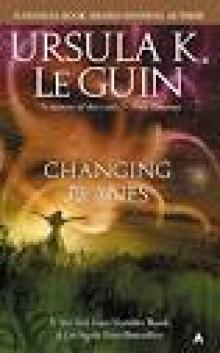 Ursula K. Le Guin
Ursula K. Le Guin Dangerous People
Dangerous People Worlds of Exile and Illusion: Rocannon's World, Planet of Exile, City of Illusions
Worlds of Exile and Illusion: Rocannon's World, Planet of Exile, City of Illusions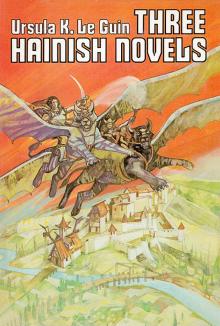 Three Hainish Novels
Three Hainish Novels The Left Hand Of Darkness (SF Masterworks)
The Left Hand Of Darkness (SF Masterworks) The Unreal and the Real - Vol 1 - Where On Earth
The Unreal and the Real - Vol 1 - Where On Earth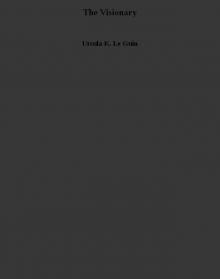 The Visionary
The Visionary The Ones Who Walk Away from Omelas
The Ones Who Walk Away from Omelas The Word for World is Forest
The Word for World is Forest Always Coming Home
Always Coming Home The Unreal and the Real - Vol 2 - Outer Space, Inner Lands
The Unreal and the Real - Vol 2 - Outer Space, Inner Lands Malafrena
Malafrena The Lathe of Heaven
The Lathe of Heaven Five Ways to Forgiveness
Five Ways to Forgiveness The Eye of the Heron
The Eye of the Heron Four Ways to Forgiveness
Four Ways to Forgiveness Powers
Powers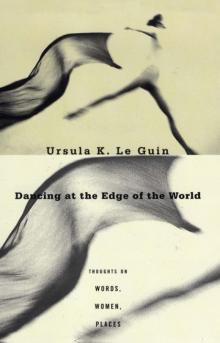 Dancing at the Edge of the World
Dancing at the Edge of the World Very Far Away from Anywhere Else
Very Far Away from Anywhere Else Voices aotws-2
Voices aotws-2 The New Atlantis
The New Atlantis The Unreal and the Real, Selected Stories of Ursula K. Le Guin Volume 1: Where on Earth
The Unreal and the Real, Selected Stories of Ursula K. Le Guin Volume 1: Where on Earth The Telling
The Telling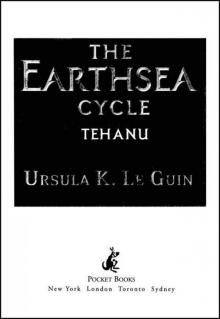 Tehanu (Earthsea Cycle)
Tehanu (Earthsea Cycle) Nine Lives twtq-9
Nine Lives twtq-9 The Birthday of the World and Other Stories
The Birthday of the World and Other Stories The Dispossessed
The Dispossessed Changing Planes
Changing Planes Words Are My Matter
Words Are My Matter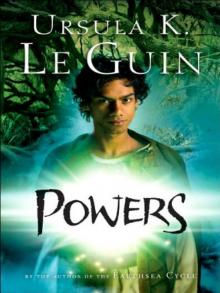 Powers aotws-3
Powers aotws-3 Lavinia
Lavinia The Wind's Twelve Quarters
The Wind's Twelve Quarters Orsinian Tales
Orsinian Tales Gifts aotws-1
Gifts aotws-1 Coming of Age in Karhide
Coming of Age in Karhide The Books of Earthsea: The Complete Illustrated Edition
The Books of Earthsea: The Complete Illustrated Edition The Found and the Lost
The Found and the Lost No Time to Spare
No Time to Spare Voices
Voices The Wild Girls
The Wild Girls Old Music and the Slave Women
Old Music and the Slave Women The Daughter of Odren
The Daughter of Odren A Fisherman of the Inland Sea: Stories
A Fisherman of the Inland Sea: Stories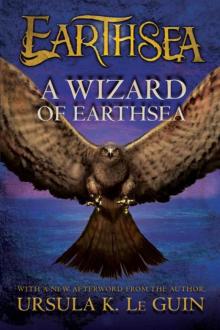 A Wizard of Earthsea (The Earthsea Cycle)
A Wizard of Earthsea (The Earthsea Cycle)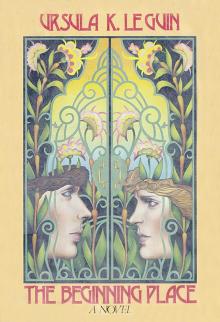 The Beginning Place
The Beginning Place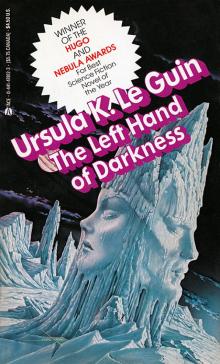 The Left Hand of Darkness
The Left Hand of Darkness The Farthest Shore (Earthsea Cycle)
The Farthest Shore (Earthsea Cycle) The Matter of Seggri botw-2
The Matter of Seggri botw-2